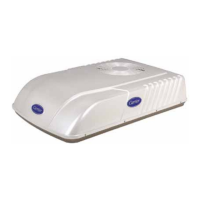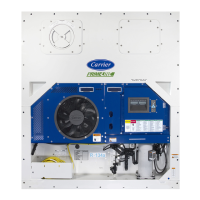4-7 T -312
e. If gauge reading is 3 psig (.2 BAR) or higher than the
calculated P/T pressure in step d, noncondensibles
are present.
f. Remove refrigerant using a refrigerant recovery
system. (Refer to paragraph 4.6.3)
g. Evacuate and dehydrate the system. (Refer to
paragraph 4.6)
h. Charge the unit. (Refer to paragraph 4.7)
4.9 CHECKING AND REPLACING HIGH
PRESSURE CUTOUT SWITCH
4.9.1 Replacing High Pressure Switch
a. The high pressure switch is equipped with schrader
valve to allow removal and installation without
pumping the unit down.
b. Unplug the wiring from the switch.
c. Check switch operation. (Refer to paragraph 4.9.2)
d. Replace switch if it does not function as outlined
below. (Refer to paragraph 4.9.2)
4.9.2 Checking High Pressure Switch
W ARNING
DO NOT USE A NITROGEN CYLINDER
WIT HO UT A PRESSURE REGULATOR
DO NOT USE OXYGEN IN OR NEAR A
REFRIGERATION SYSTEM AS AN
EXPLOSION MAY OCCUR.
a. Remove switch from unit. All units are equipped with
schrader valves at the high pressure switch
connection.
b. Connect an ohmmeter across switch terminals. If the
switch is good, the ohmmeter will indicate continuity,
indicating that the contacts are closed.
1. Cylinder Valve
and Gauge
2. Pressure Regulator
3. Nitrogen Cylinder
4. Pressure Gauge,
0 to 400 psig
(0 to 2.8 mPa)
5. Bleed-Off Valve
6. 1/4 inch Connection
1
2
3
4
5
6
Figure 4-5. Checking High Pressure Switch
c. Connect switch to a cylinder of dry nitrogen. (See
Figure 4-5)
d. Set nitrogen pressure regulator higher than cutout
point on switch being tested. (Refer to paragraph 1.3)
e. Open cylinder valve. Slowly open the regulator valve
to increase the pressure until it reaches cutout point.
The switch should open, which is indicated by an
infinity reading on an ohmmeter (no continuity).
f. Close cylinder valve and release pressure through
the bleed-off valve. As pressure drops to cut-in point,
the switch contacts should close, indicating continuity
on the ohmmeter.
4.10 FILTER-DRIER
4.10.1.T o Check Filter Drier
Check for a restricted or plugged filter-drier by feeling
the liquid line inlet and outlet connections of the
filter-drier . If the outlet side feels cooler than the inlet
side, then the filter-drier should be changed.
4.10.2.T o Replace Filter Drier
a. Pump down the unit. (Refer to paragraph 4.4)
b. Replace filter-drier, ensuring that the arrow points in
the direction of the refrigerant flow.
c. Drier can be evacuated at liquid line service valve.
(See Figure 4-4)
d. Check refrigerant charge. (Refer to paragraph 4.7.1)
1. Power Head Assembly
2. Equalizer Connection
3. Bulb
4. Cage Assembly
5. Seat Gasket
6. Body Flange
7. Capscrew
8. Body Flange Gasket
1
2
3
4
5
6
7
8
Figure 4-6. Thermostatic Expansion Valve
4.11 THERMOSTATIC EXPANSION VALVE
The thermostatic expansion valve (TXV) is an
automatic device which maintains constant superheat
of the refrigerant gas leaving the evaporator regardless
of suction pressure. The valve functions are: (a)
automatic response of refrigerant flow to match the
evaporator load and (b) prevention of liquid refrigerant
returning to the compressor. Unless the valve is
defective, it seldom requires any maintenance. All
TXV’s are non--adjustable.
4.1 1.1 Replacing the Expansion Valve (See
Figure 4-6)
a. Pump down low side of the unit. (Refer to paragraph
4.4)
b. Remove insulation (Presstite) from expansion valve
bulb.

